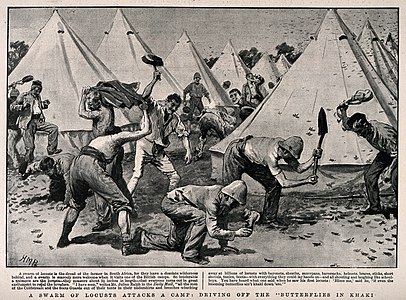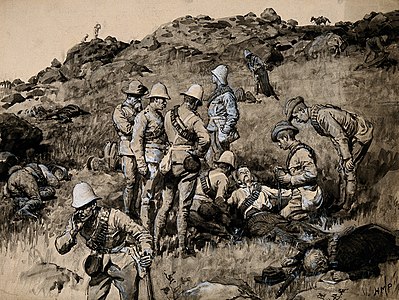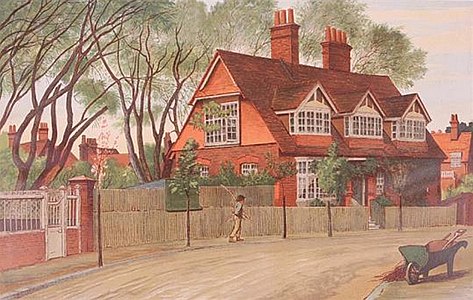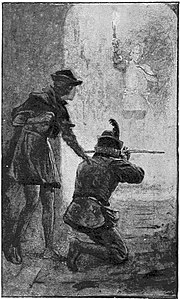Henry M. Paget

Henry Marriott Paget | |
|---|---|
| Born | 31 December 1857 |
| Died | 27 March 1936 (aged 78) |
| Known for | Portraits and illustrations of historic events |
Henry Marriott Paget RBA (1856–1936) was a British painter and illustrator, who signed his work "HMP".
Paget, along with his brothers, Sidney Paget and Walter Paget, provided illustrations for works by Arthur Conan Doyle.[1]
Work
[edit]Newspaper illustration
[edit]Illustrated papers like the Illustrated London News often had an artist rework the foreign correspondent's material to produce a drawing from which the engraving could be prepared. This was particularly the case with rough sketches, and initially with photographs. Paget prepared sketches and photographs from the Greco-Turkish War (1897) and the Boer War by war-correspondents for publication. Hodgson notes that almost all the illustrations published by The Sphere during the Boer War were redrawn in London.[2]
- Greek retreat from Domokos - Crown Prince Constantine and entourage
- Soldiers in camp driving off a swarm of locusts with anything to hand.
Newspaper illustrations turned into paintings
[edit]Paget sometimes turned sketches into brush and wash or watercolour paintings, as in some of his work from the Boer War.
- Removing the wounded after battle from Skion Kop
- British soldiers tending the wounded Boers after a battle at Potgieter's Drift
Painting
[edit]In addition to his work as an illustrator, he was known in England as a painter, executing portraits, street scenes, and scenes from history and Greek mythology.
He contributed a painting to an 1882 book Bedford Park, celebrating the then-fashionable garden suburb of that name.[3]
- Painting of 7 Queen Anne's Gardens, London, 1882
Book illustration
[edit]Kirkpatrick lists over fifty books illustrated by Paget.[4]
Henry Paget provided illustrations for the 1890 edition of Doyle's story, "Micah Clarke," published by Longmans, Green, and Company.[5]
The Black Arrow by Robert Louis Stevenson had first been published as a serial in Young Folks in 1883 and it was a huge success.[6] Cassell & Co. published the story as a book in 1888, and it was such a success that the first printing sold out to the book trade even before it was published.[7] Cassell brought out a new edition with illustrations by Paget in 1891.[4] The illustrations below are from the 1897 edition by Cassell, from scans at the British Library.[8]
- The crossbow man aimed at the unsuspecting target.
- The horse neighed and upset the ferry.
References
[edit]- ^ The Artur Conan Doyle Encyclopedia -- Henry M. Paget
- ^ Hodgson, Pat (1977). "Introduction". The War Illustrators. New York: Macmillan Publishing. p. 24.
- ^ Dollman, John Charles; Hargitt, Edward; Harrison, Thomas Erat; Jackson, F. Hamilton; Nash, Joseph Jr.; Paget, H. M.; Rooke, Thomas; Trautschold, Manfred; Brooks, Vincent; Carr, Jonathan T.; Berry, Berry F. (1882). Bedford Park. Harrison and Sons. OCLC 193146366.
- ^ a b Kirkpatrick, Robert J. (11 July 1905). "W. H. Overend". The Men Who Drew For Boys (And Girls): 101 Forgotten Illustrators of Children's Books: 1844-1970. London: Robert J. Kirkpatrick. p. 309.
- ^ The Artur Conan Doyle Encyclopedia -- Henry M. Paget
- ^ Steuart, John Alexander (1928). "Unromantic Reality and Some Engaging Philosophy". Robert Louis Stevenson: a critical biography. pp. 383–384. Retrieved 2 May 2020.
- ^ "Literature and Art". Aberdeen Evening Express (Monday 13 August 1888): 2. 13 August 1888.
- ^ Stevenson, Robert Louis (1897). The Black Arrow: A Tale of the Two Roses. Retrieved 2 May 2020.
External links
[edit]- Works by Henry M. Paget at Project Gutenberg
- H.M Paget at Library of Congress, with 5 library catalog records
- Henry Marriott Paget at ARt UK
- Works by Paget at the Wellcome Collection.
- detailed biography of H. M. Paget On the Bear Alley blog. This blog was written by Kirkpatrick and is an draft version of the biography in Kirkpatrick's book: Kirkpatrick, Robert J. (2019). "W. H. Overend". The Men Who Drew For Boys (And Girls): 101 Forgotten Illustrators of Children's Books: 1844-1970. London: Robert J. Kirkpatrick. p. 309.






